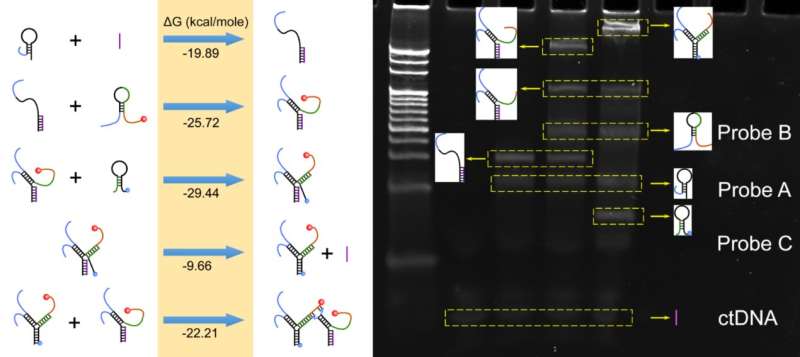Scientists develop novel electrochemical/fluorescent dual-mode biosensor

Researchers at the Suzhou Institute of Biomedical Engineering and Technology (SIBET) of the Chinese Academy of Sciences have recently proposed a hand-in-hand structured DNA assembly strategy and developed an electrochemical/fluorescent dual-mode biosensor for circulating tumor DNA based on methylene blue and red-emissive carbon nanodots.
The new sensor, combines the characteristics of electrochemical and fluorescent sensors, whose signal sources and construction methods are usually quite different, according to the researchers.
And electrochemical sensor is a qualitative or quantitative method based on the correlation between target-caused change of electrical signal and the concentration or other physical parameters. A fluorescence sensor is a method of qualitative or quantitative detection by transmitting a specific combination of target and recognition element to the fluorescence element, causing the change of fluorescence intensity or emission wavelength.
"Integrating the two technologies for synchronous detection in one unique system can not only effectively improve the detection accuracy, but also reduce the influence of background signals, instrument fluctuations and other factors on the obtained signals," said Miao Peng, leading researcher of the study and also a scientist from SIBEBT.
Specifically, Probe A in this sensor is immobilized at the electrode surface via the thiol group labeled at its 5' terminal. In the presence of target, complete double strands are formed between target and its binding domain in Probe A.
Meanwhile, the stem region is opened and single-stranded region is released which is responsible to open the second hairpin of Probe B. It is previously conjugated with red emissive carbon nanodot through the 3' terminal NH2. Subsequently, the hairpin structure of Probe C is opened with the released single-stranded region of Probe B.
In addition, Probe C is able to displace the target sequence to form a complete three-way junction structure. The target is thus recycled and assists the formation of multiple three-way junctions. Since abundant methylene blue molecules at the 3' terminal of Probe C are located near the electrode interface, significant electrochemical response could be recorded to reveal the target.
The released single-stranded swing arm formed by the 3' terminal of Probe A and the 5' terminal of Probe B on the three-way junction acts as the DNAzyme coupling 3' terminal of Probe B on the adjacent three-way junction as the substrate. Hand-in-hand structured DNA monolayer is thus fabricated.
With the existence of Mg2+, the substrate sequence can be cleaved and the conjugated carbon nanodots are released into the solution. "By measuring the increased fluorescence emission, original target level can also be evaluated by fluorescence technique," said Miao.
Theoretical calculation and gel electrophoresis imaging confirmed the feasibility of the reaction. The synthesized carbon nanodots have strong anti-interference and can maintain high fluorescence stability in the physiological environment.
Through a series of condition optimization and quantitative tests, Miao and his team established the linear calibration curves of electrochemical/fluorescence intensities and target concentration, which can achieve a wide linear range of six orders of magnitude.
At the same time, the content of the target can also be easily distinguished by fluorescence imaging. The dual-mode sensor developed in this work is novel with high sensitivity and strong scalability, which can provide a powerful tool for nucleic acid analysis and clinical diagnosis.
The sensor is expected to be widely used in basic research, environmental detection, clinical trials and other fields.
The results of the study were published in the latest issue of the Chemical Engineering Journal.
More information: Guangxing Liu et al, Hand-in-hand structured DNA monolayer for dual-mode analysis of circulating tumor DNA, Chemical Engineering Journal (2022). DOI: 10.1016/j.cej.2022.138069
Provided by Chinese Academy of Sciences


















